|
|
|
Sort Order |
|
|
|
Items / Page
|
|
|
|
|
|
|
| Srl | Item |
| 1 |
ID:
180615
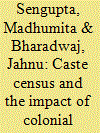

|
|
|
|
|
| Summary/Abstract |
This essay challenges the salience of the caste question for writing a social history of modern Assam. It argues that pre-colonial records contained enough indicators for arguing that caste in Assam was never a rigid and impermeable social grid. The variegated nature of Assam’s geo-political and cultural past meant that the progress of Brahmanical culture here was neither smooth nor unmitigated. The essay argues that the region’s social and cultural intricacies could not be comprehended through an interpretive framework developed in a pan-Indian context. The same was, however, used by the census officials to streamline the region’s discrete patterns into rigidly structured hierarchies and uniformly imagined categories. Through a close reading of the pre-decennial and decennial census reports and other records from the nineteenth century, this essay identifies numerous misreading of local level empirical data that enabled the British to produce a uniform caste history for the region.
|
|
|
|
|
|
|
|
|
|
|
|
|
|
|
|
| 2 |
ID:
111900
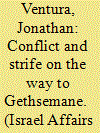

|
|
|
|
|
| Publication |
2012.
|
| Summary/Abstract |
Marian rituals have been the apex of Christian believers' journey for centuries. Although its research importance in many disciplines, Marian devotion and rituals in Israel have been largely neglected. This article outlines several social and religious aspects of 'the public dimension of the ritual'. These aspects include several lines of conflict and strife taking place between a myriad array of socio-ethnic groups: between the Greek Orthodox and the Palestinian Greek Orthodox communities; between the Palestinian Greek Orthodox communities and clergymen; between Palestinian believers and pilgrims; and between the Greek Orthodox and Jews/Muslim believers. This research is based upon a combination of two principal qualitative methodologies: participant observations which took place over a period of three years and in-depth interviews with believers and clergymen. The fieldwork is focused around a procession taking place in the Old City of Jerusalem at the end of August, celebrating Mary's death and resurrection.
|
|
|
|
|
|
|
|
|
|
|
|
|
|
|
|
| 3 |
ID:
189069
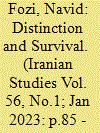

|
|
|
|
|
| Summary/Abstract |
This article argues that the notion of Iranian culture employed in the public discourse of Zoroastrians allows them to tackle the dilemma of Shiʿi-dominated Iranianness without provoking Shiʿi authorities. The piece offers an analysis of ethnographic data, including detailed speech acts documented in Zoroastrians’ ritual spaces and cultural exhibitions. It explores the Zoroastrian configuration of an Iranian culture that summons and encodes pre-Islamic tropes and modern nationalist sentiments by constantly maneuvering around national, religious, and ethnic categories. This configuration's underpinning assumptions, narratives, and texts have powerful platforms in Iranian nationalist imagination. I propose that this arrangement attempts to carve out a space for Zoroastrians’ distinct identity by connecting the history of the Muslim Arab invasion of Persia to the Shiʿi hegemonic norms of Iranian culture today. It further invokes Zoroaster's indigeneity and teachings as the foundation of authentic Iranianness to establish Zoroastrians’ survival as a cultural system.
|
|
|
|
|
|
|
|
|
|
|
|
|
|
|
|
| 4 |
ID:
193234
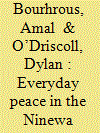

|
|
|
|
|
| Summary/Abstract |
Although the need for local ownership of peacebuilding is routinely emphasized, the importance and the modalities of engaging with local cultures and traditions are not adequately understood, and the peacebuilding potential of local customs remains largely unharnessed. Drawing on extensive interviews with community leaders (n94) and farmers and villagers (n107), and using a conceptual framework that combines notions of the everyday and events that mark a rupture with the everyday, this article explores the opportunities that local people’s everyday interactions, culture, and traditions offer for peacebuilding in post-Islamic State Ninewa Plains, Iraq. In doing so, the article makes a theoretical contribution to the everyday peace literature by further developing existing typologies of everyday acts and attitudes of everyday peace. Demonstrating how everyday acts and attitudes of peace sit on a scale with negative peace on the one end and positive peace on the other, the article introduces the concept of ‘affinity’ on the positive peace side of the scale, to refer to an affective engagement with the other and to acts of getting to know, understand, and participate in what is important to the other community.
|
|
|
|
|
|
|
|
|
|
|
|
|
|
|
|
| 5 |
ID:
159756
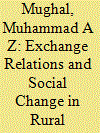

|
|
|
|
|
| Summary/Abstract |
In recent decades, the nature of exchange relations in rural Pakistan appears to have undergone significant transformations due to the gradual shift from seasonal agriculture to a market-based economy, rapid urbanisation and industrialisation. Change and continuity in exchange relations are particularly manifested in rituals and ceremonies associated with childbirth, marriage and death, with socioeconomic transformations in the rural economy triggering shifts in ways of conducting such rituals and ceremonies. This article seeks to highlight such change but argues that the continuing centrality of religion, kinship and economic inter-dependencies, marked by rural social organisation, remains evident in how these rituals and ceremonies are conducted. After discussing the social meanings of such rituals and ceremonies in rural Pakistan, the article demonstrates through detailed ethnographic study certain modifications in exchange relations as a consequence of recent socioeconomic change.
|
|
|
|
|
|
|
|
|
|
|
|
|
|
|
|
| 6 |
ID:
141775
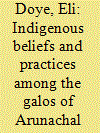

|
|
|
|
|
| Summary/Abstract |
This fieldwork-based article provides an ethnographic overview of surviving traditional ritual practices and underlying belief systems among the Galos of Arunachal Pradesh. Since most of this community recently converted to Christianity, many of the details outlined here may soon be forgotten and no longer practised, or will be only used when other patterns of recourse to remedies for distress have shown no results. The evidence presented indicates the continued presence of ancient holistic worldviews that may be dismissed by others as ‘primitive’ but whose followers seek to fall in line and clearly connect themselves with locally grounded forces beyond immediate human control.
|
|
|
|
|
|
|
|
|
|
|
|
|
|
|
|
| 7 |
ID:
103136
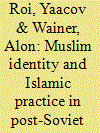

|
|
|
|
|
| Publication |
2009.
|
| Summary/Abstract |
After the dissolution of the Soviet Union, the newly independent countries of Central Asia had the opportunity to endorse religious freedom. Nevertheless, they chose for the most part to continue the policy of monitoring religious activity, on the pretext of protecting their countries from radical Islam. This study focuses on Islamic praxis in post-Soviet Central Asia. Based on a survey conducted in four Central Asian successor states (excluding Turkmenistan), it examines everyday Islam - observance of precepts, life-cycle rites, prayer and mosque attendance - as well as people's perceptions about the role of Islam in their lives and in the evolution of their societies and the place of Islam in local identity. The authors' findings have not always corresponded to usually accepted hypotheses and they have sought to analyse the reasons for this. Undoubtedly, the exigencies of the current political situation both act as a restraint on respondents in addressing the questions put to them and restrict their religious praxis outside the home. It is difficult to assess how far responses would have differed had the survey been conducted under more favourable circumstances; indeed, some of the questions may have been genuinely misinterpreted as a result of differences in outlook and the use of concepts.
|
|
|
|
|
|
|
|
|
|
|
|
|
|
|
|
| 8 |
ID:
169976
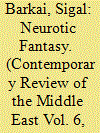

|
|
|
|
|
| Summary/Abstract |
In the political reality of Israel, some symbols lie at the heart of the political, religious, national, and historical discourse that characterize the peoples and cultures living on the Israeli-Palestinian soil. Among these, the Temple Mount in Jerusalem is one of the most complex and conflictual symbols. The multiple religious claims to the Temple Mount—Jewish, Christian, and Muslim—are the subject of extensive study, but this article focuses on their reflection in contemporary Israeli art. In traditional Jewish art, the visual representations of the Temple or of Jews praying nearby expressed the longing of the Jews for generations to return to the Mount. In contrast, Yael Bartana and Nira Pereg view the multiple socio-political currents and religious rituals surrounding the Temple Mount as a reflection of the internal public debate regarding the face of the Israeli society today. This article discusses the contribution of their visual art to a conscious and aware discourse about the Israeli society and the underground currents that shape its contemporary identity. The analysis of their work tracks a “politics of aesthetics”—interpretation of the images within a socio-political context—and draws upon Israeli sociology, art history, and visual culture. In-depth personal interviews with the artists also inform the analysis.
|
|
|
|
|
|
|
|
|
|
|
|
|
|
|
|
| 9 |
ID:
089596
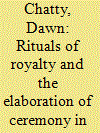

|
|
|
|
|
| Publication |
2009.
|
| Summary/Abstract |
Tradition and ceremonies have always been invented, elaborated, and refined to meet the needs of those in power, to support perceptions of social cohesion and group membership, and to legitimize particular relations of authority. The invented ceremonies and traditions of the British monarchy are particularly exemplary of this process in their growing splendor, popularity, and public appeal.
This article explores the creation and elaboration of certain ceremonials and court rituals in the Sultanate of Oman after the accession of Sultan Qaboos in 1970. It investigates the relationship betbeen the development of thsese ceremonial and ritual events and the perception of leadership between the development of these ceremonial and ritual events and the perception of leadership and authority in the person of the sultan, as well as the development of sentiment of common nationality.
|
|
|
|
|
|
|
|
|
|
|
|
|
|
|
|
| 10 |
ID:
106311
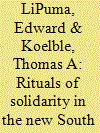

|
|
|
|
|
| Publication |
2011.
|
| Summary/Abstract |
There is a deep connectivity between the construction of peoplehood and the fabrication of rituals, especially national secular rites of commemoration. The article examines this connection through an analysis of the process of ritualisation in post-apartheid South Africa focusing on Nelson Mandela's incarceration on Robben Island and subsequent efforts to create a memorial to both person and place.
|
|
|
|
|
|
|
|
|
|
|
|
|
|
|
|
| 11 |
ID:
190088
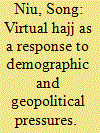

|
|
|
|
|
| Summary/Abstract |
Hajj is the most important one of the Five Pillars in Islam. Islam makes the Kaaba as the orientation of daily prayers (salat), and hajj as the linkage to maintain the global Muslim faith community. The sanctity of hajj rituals is of positive significance for global pilgrims to transcend the boundaries of countries and ethnic groups. In the era of globalization, hajj quota has long been a scarce resource. It is difficult for most Muslims to obtain hajj permits from Saudi Arabia in a short term. Even non-Muslims are full of concern about Islam, especially the hajj. Then, the “virtual hajj,” which is similar to the real hajj in the sacred city Mecca, came into being. It is mainly divided into several types: (1) building the real scenes of Kaaba and other hajj sites, and Muslims participating in the “virtual hajj” through role-playing; (2) the “virtual hajj” apps developed through 3D digital technology and their upgraded versions; (3) the “virtual hajj” live broadcasting the real hajj to non-pilgrims through the pilgrim’s smartphone with the 5G network technology; and (4) the “virtual hajj” software developed by VR and AR technology in the Metaverse era. The main functions of “virtual hajj” are embodied in four aspects: protest against Saudi Arabia, Islamic education, universal effect, and the COVID-19 fighting. All types of “virtual hajj” have positive effects on both the Muslims and non-Muslims. However, there are different voices from religious circles on how to treat “virtual hajj.”
|
|
|
|
|
|
|
|
|
|
|
|
|
|
|
|
|
|
|
|
|